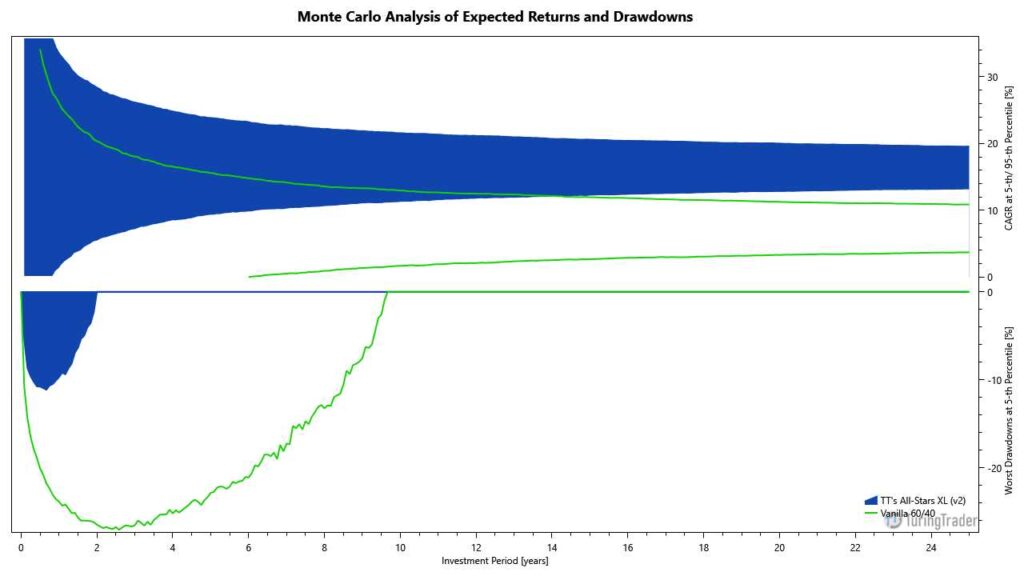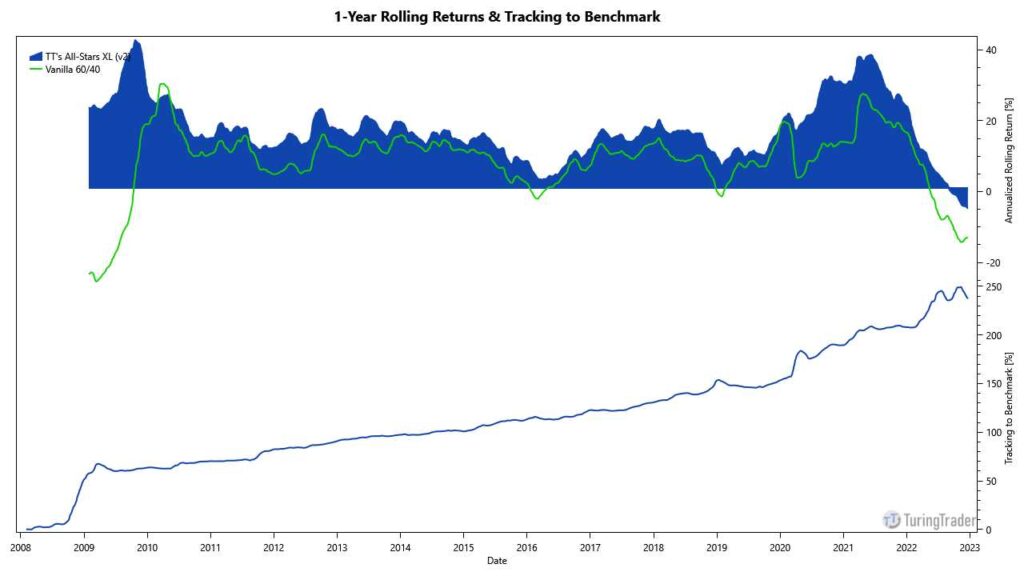Summary
- Objective: balanced growth
- Type: momentum strategy
- Invests in: ETFs tracking stocks, bonds, real estate, gold
- Rebalancing schedule: monthly
- Taxation: 50% short-term capital gains
- Minimum account size: $5,000
Gary Antonacci is an industry veteran with over 35 years of experience as an investment professional. Gary published the Dual Momentum strategy in his book Dual Momentum Investing, which he released in 2015.
Our version of Dual Momentum uses a fixed allocation towards five asset classes: U.S. equities, Treasury bonds, REITs, corporate bonds, and gold. The strategy holds the respective assets only if their return exceeds that of a T-bill. Otherwise, Antonacci’s strategy invests that tranche in the aggregate bond market.
Dual Momentum rebalances its assets once per month. In conjunction with the low number of traded ETFs, this leads to very low maintenance requirements.
Performance
This table shows the portfolio’s key performance metrics over the course of the simulation:
The following chart shows the portfolio’s historical performance and drawdowns, compared to their benchmark, throughout the simulation:
This chart shows the portfolio’s annual returns:
The following charts show the Monte-Carlo simulation of returns and drawdowns, the portfolios 12-months rolling returns, and how the portfolio is tracking to its benchmark:


Asset Allocation
The portfolio last required rebalancing after the exchanges closed on @last-rebal@. Due to fluctuations in asset prices, the exact allocations vary daily, even when no rebalancing occurred. The current asset allocation is as follows:
Sign up for our FREE Basic membership to see the asset allocation.
Sign up for our FREE 14-day trial to see the asset allocation.
Strategy Rules
Even though Antonacci’s book introduces multiple flavors of Dual-Momentum portfolios, his Global Equities Momentum (or GEM for short) is by far the best-known variant. If you are interested in the GEM portfolio, we recommend checking out Engineered Portfolio’s Accelerating Dual Momentum, which is closely related. For this site, we picked one of the lesser-known variants from Antonacci’s book: The Parity Portfolio with Absolute Momentum, which he describes in appendix B. The operation of this strategy can be summarized as follows:
- trade U.S. stocks, U.S. Treasuries, REITs, corporate bonds, and gold
- invest 20% in each asset class if its 12-months momentum is larger than that of a T-bill
- otherwise, invest the tranche in the aggregate bond market instead
For full detail, we recommend reading Antonacci’s book Dual Momentum Investing. Further, the complete C# source code is available as part of the TuringTrader.org open-source project.
Diversification
We like the concept of combining a fixed asset allocation with a tactical component a lot. This scheme makes sure that the portfolio stays stable and well-diversified under all market conditions and avoids potentially harmful concentration risks. Furthermore, this allocation is quite conservative, allowing investors to allocate 100% of their capital toward the strategy or even apply some leverage.
The Monte-Carlo simulation shows the benefits of this diversification. Returns and drawdowns are considerably more predictable than with a 60/40 portfolio, which results in much less slanted curves. Also, the portfolio’s risk profile is about 30% lower than its benchmark, leading to higher risk-adjusted returns.
Returns & Volatility
Like many portfolios of this kind, Antonaci’s strategy follows a ‘win more by losing less’ philosophy: it will generally lead passive portfolios during recessions but lag during bull markets. Therefore, investors should always contemplate the strategy’s performance over the entire economic cycle.
The rolling returns confirm that the Dual Momentum portfolio is generally lagging its benchmark while doing a great job of avoiding the 2008 downturn. However, because of its monthly rebalancing schedule and its 12-months horizon for momentum, the mechanism is too slow to follow fast-paced changes in market conditions. Consequently, the strategy provided only little benefits in late 2018 or spring 2020 and missed out on quick market rebounds.
The tracking chart shows how the Dual Momentum has gained nicely over its benchmark until 2012 but has continuously trailed its benchmark since. Moreover, given that the strategy is heavy on bonds, we are concerned that it will fall even further behind when yields rise again in the future.
In our opinion, the strategy could benefit from a more aggressive allocation toward stocks and corporate bonds and a much lower allocation toward gold. One possibility to achieve this is to pair the portfolio with a small investment in a stock-oriented strategy.
Account & Tax Considerations
When Dual Momentum changes its selection of ETFs, it triggers taxable events. However, because each asset class only switches between risk-on and risk-off behavior, this only happens infrequently. Thus, while the strategy still works best in tax-deferred accounts, holding assets long enough to qualify for long-term taxation of capital gains is a good chance.
Dual Momentum invests in up to five ETFs simultaneously. Therefore, it works well with account sizes of $5,000 or more.
